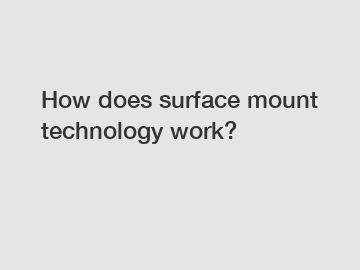Mar. 10, 2024
Machinery
Surface mount technology (SMT) is a method used to construct electronic circuits in which the components are mounted directly onto the surface of a printed circuit board (PCB). This method has become the preferred choice for electronic manufacturers due to its many advantages, including cost-effectiveness, improved reliability, and higher component density. Here is a step-by-step explanation of how surface mount technology works.
**Step 1: Component Placement**.
First, electronic components such as resistors, capacitors, integrated circuits, and other devices are designed to be mounted directly onto the surface of the PCB. These components are typically smaller and lighter than their through-hole counterparts, making them ideal for surface mounting.

**Step 2: Solder Paste Application**.
A stencil is used to apply solder paste to the pads on the surface of the PCB where the components will be placed. The solder paste is a mixture of flux and tiny balls of solder that will hold the components in place and create a strong electrical connection.
**Step 3: Pick-and-Place**.
An automated pick-and-place machine is used to accurately place the components onto the solder paste on the PCB. The machine uses vacuum nozzles to pick up the components from reels or trays and place them onto the correct pads with precision.
**Step 4: Reflow Soldering**.
Once all the components are in place, the PCB goes through a reflow soldering process. The entire board is heated in a special oven, causing the solder paste to melt and create a permanent bond between the components and the PCB. This process ensures reliable electrical connections.
**Step 5: Inspection**.
After reflow soldering, the PCB is inspected to ensure that all components are correctly placed and soldered. Automated optical inspection (AOI) machines are often used to detect any defects, such as misaligned components or solder bridges.
**Step 6: Testing**.
Finally, the assembled PCB undergoes functional testing to ensure that all components are functioning correctly and the circuit operates as intended. Any faulty components or connections are identified and replaced before the board is considered finished.
**Conclusion**.
In summary, surface mount technology works by mounting electronic components directly onto the surface of a PCB using solder paste and reflow soldering. This method allows for smaller, more densely packed circuits with improved reliability and cost-effectiveness. By following these step-by-step processes, manufacturers can produce high-quality electronic devices using SMT.
For more information, please visit Smd Magazine, Smd Transistor Package Types, Surface Mounted Devices Company.
Previous: What are the benefits of a dump truck?
Next: Top 5 Benefits of LV Motors: Answers to Your Burning Questions
If you are interested in sending in a Guest Blogger Submission,welcome to write for us!
All Comments ( 0 )